The Container revolution
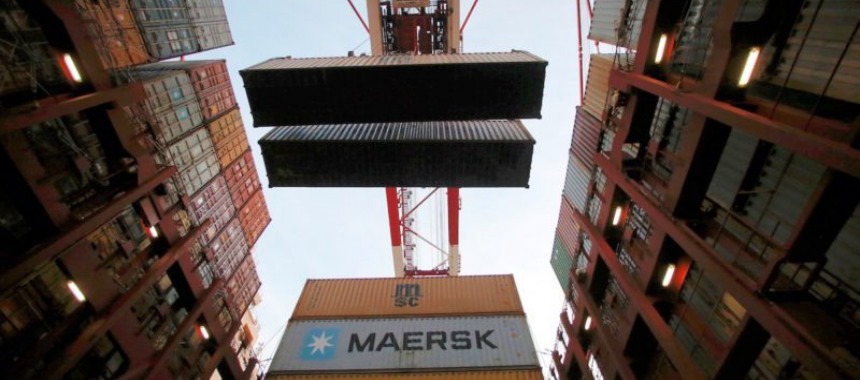
The transportation of cargo from manufactories around the world to ports for loading, its movement across the oceans to points of debarkation, and then its arrival at local loading docks transpires on a routine, seamless basis. The process is so smooth that, only after the terrorist attacks of September 11, 2001, did the nation awaken to learn that only a small percentage of the more than 23 million containers that arrive yearly in this country are inspected. While this is clearly a topic lawmakers are addressing as far as homeland security is concerned, it also points to the fact that the volume of commerce in and out of the nation, along with the rest of the world, has increased exponentially since the end of the Second World War. The reasons for this change are numerous: globalization, better production techniques, mechanization, and improved management styles. Perhaps the most significant factor, and one usually overlooked, is that the capability to move cargo overseas in large quantities and in a way that allows for quicker turn-around in port has only been effected in the last few decades. This style of cargo handling, containerization, has led to a shipping revolution.
The early movement of cargo on and off ships can best be described in one word, manpower. Devices magnified this power, but the use of humans, or sometimes animals, remained a constant theme throughout most of history. Blocks and tackle mounted on masts or on shore provided a mechanical advantage for lifting large weights. The breaking strain of wood required massive booms and limited the size of the cargo that could be stowed onboard. The introduction of iron into shipbuilding allowed for smaller and more capable booms. In addition, this style of construction permitted the enlarging of cargo deck hatches. The combination of steam propulsion with iron, and later steel construction, mechanically-powered winches, electricity, and telegraph cables revolutionized the shipping industry in the late nineteenth century and introduced to the world the standard boom (or stick) freighter. Yet, with all these innovations, the movement of cargo by sea had changed little since ancient times.
Cargo has always been moved easier by water than over land. Even today, ninety percent of the world’s commerce moves on the sea.
Throughout history, humans have continually used containers to move their goods. The Egyptians used straw baskets to load on ships, along with amphora's to carry liquid cargo. This style of transportation still exists today in several parts of the world. The development of wooden crates for shipping, barrels for liquid products, and bags for grain allowed for increased productivity in cargo operations, but they were still limited by the power source.
The introduction of material handling equipment accelerated the cargo process. Motorized hand trucks, such as forklifts, dock tractors, crane trucks, and powered conveyors radically altered cargo operations. When these were added to four-foot by four foot wooden pallets, workers were able to move cargo in a third of the time. In the years after World War II, the standard stick freighter, exemplified by the Liberty, Victory, and C-class cargo ships of the US Maritime Commission, was the most common dry cargo ship sailing on the world’s oceans. As the demand for cargo increased larger freighters were built, such as the thirty-five C-4 Mariner class in the early 1950s, but they were not the solution. What was needed was an entirely new way to move cargo, not just bigger freighters.
In 1955, a North Carolina trucking entrepreneur, Malcolm McLean, acquired the Pan-American Steamship Company out of Mobile, Alabama, a subsidiary of Waterman Steamship. Using a concept developed by Seatrain Lines in the 1930s, he initially favored the construction of ‘trailer ships’ — taking trailers from large trucks and stowing them in a ship’s cargo hold. This method of stowage, referred to as roll-on/roll-of, was not adopted because of the large waste in potential cargo space onboard the vessel, known as broken stowage. Instead, he modified his original concept into loading just the containers, not the chassis, onto the ships, hence the designation container ship, or «box» ship. In January 1956, he purchased three T-2 tankers and oversaw the construction of wooden shelter decks, known as Mechano decking. This was a common practice in World War II for the carriage of oversized cargo, such as aircraft.
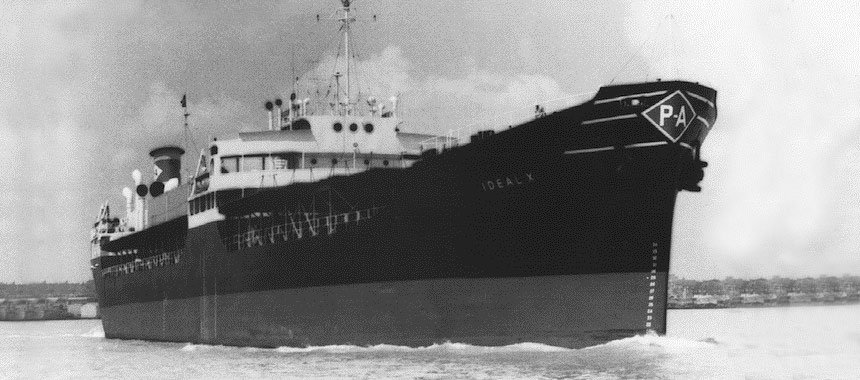 The first container ship SS Ideal X
The first container ship SS Ideal X
The first ship with containers, SS IDEAL-X, sailed from Port Newark, New Jersey, for Houston, Texas, on 26 April 1956 and opened a new age in cargo transportation. Shipping firms were slow to embrace McLean’s concept. The conversion of existing ships provided the first generation in containerships. Many of these vessels, such as the C-3 freighters altered by Matson Lines in the Pacific, merely added lashings on deck for the securing of containers. The existing booms served as the means to load and unload the boxes. Yet, the addition of containers did not solve the problem of cargo throughput. A lack of standardization in container length and height persisted and forced dedicated service between trucking firms and shippers, precluding the introduction of true intermodalism — the seamless movement of cargo from shore to ship to shore. McLean’s new company, Sea-Land, based on the East Coast, preferred thirty-five-foot long containers, while Matson on the West Coast, used twenty-four-footers. Not until 1961 did the International Standards Committee set up formal sizes: the twenty-foot equivalent unit (TEU = 20’ length X 8’ width X 8.5’ height) and the forty-foot equivalent unit (FEU = 40’ X 8’ X 8.5’).
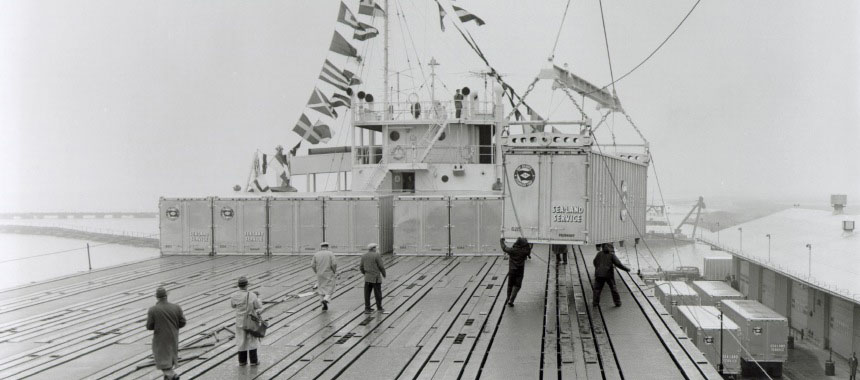 Loading a container on the deck of conteiner ship SS Ideal X in 1956
Loading a container on the deck of conteiner ship SS Ideal X in 1956
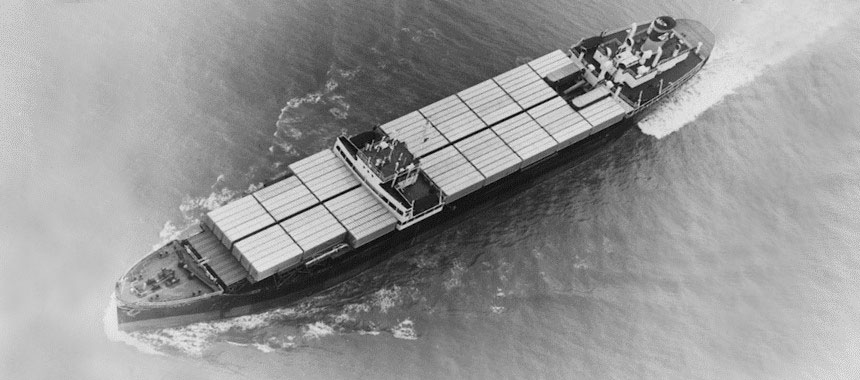 The container ship SS Ideal X
The container ship SS Ideal X
A major technological improvement in the transportation of containers came with the introduction of cellular construction. The installation of vertical rails in the holds of ships, known as cell guides, in conjunction with high-speed shore cranes, made container handling quicker and more efficient. Yet, the transition to container ships did not always proceed smoothly. Grace Lines suffered a severe setback in their trade with the west coast of South America by introducing containers before the market could sustain them. In addition, they incurred the wrath of local labor when stevedores and longshoremen refused to move the containers for fear of losing their jobs. Many companies also faced the challenge of vessel replacement. As their war-built fleets were nearing the end of their service lives, many firms had to choose what type of ships to build. Some companies went with larger freighters; some went with barge carrying vessels, others with roll-on/roll-of ships. Even containerships did not prove to be the right choice initially. In 1960, American President Lines constructed two ships that represented a transition point from break-bulk stick freighters to true container ships.
The Searacers provided for a mix of container transport and break-bulk cargo. The two conflicting systems of cargo transportation proved inefficient and incompatible, but, nevertheless, symbolic of the cross-roads that the shipping industry faced in terms of technology.
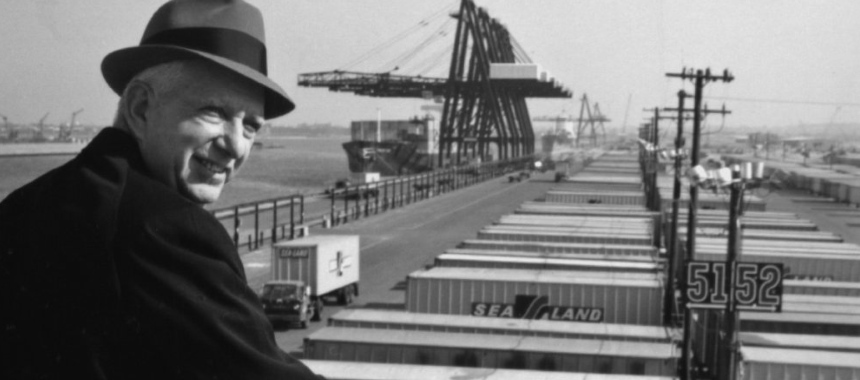 Malcolm McLean (1914-2001)
Malcolm McLean (1914-2001)
It was the Vietnam War that demonstrated the true value of the container ship. To deliver the mountains of supplies needed to support the armed services, the Military Sea Transportation Service (today known as the Military Sealift Command) contracted with Malcolm McLean. In April 1966, Sea-Land initiated container service between the east coast of the United States and Bordeaux, France, and Hamburg, Germany. McLean assigned five converted C-2 ships to this route. This expedient only provided partial relief for his ailing company and, on 29 March 1967, he signed an agreement with MSTS that opened the door for containers into Vietnam. The agreement contained provisions for Sea-Land to transport the containers, not merely to Vietnamese ports, but, once ashore, to inland depots. This unusual provision was the backbone of true intermodalism. Because Sea-Land was now responsible for the ground movement, they were able to track shipments, retain oversight of the containers, and ensure that the empty boxes were returned for further use. All told, seven containerships, along with four making stops at Okinawa and the Philippines, accounted for ten percent of the entire sustainment cargo shipped during the course of the Vietnam War. By the end of the conflict in 1973, eighty percent of all cargo shipped to Southeast Asia went by container. Malcolm McLean had revolutionized sealift, and, while the military was slow to realize it, the commercial sector took the lesson to heart.
Many firms began to place orders for the second generation of containerships that were purpose-built to carry containers.
In 1968 United States Lines introduced the Lancers. They were innovative in that they were totally denuded of any cargo gear, relying instead on shore-side cranes. This allowed for every avail- able space on the vessel to be devoted to the transportation of 1,178 TEUs. With a service speed of twenty-two knots, the eight ships in this class allowed United States Lines to replace twenty-four older first-generation ships and still be more productive.
Container ships continued to grow in size and capabilities. The third-generation vessels all emphasized an increase in the number of containers carried while also reducing fuel consumption and maximizing their size to the very limits of the Panama Canal referred to as «Panamax.» In 1980, Sea-Land introduced the D-9 class, the first in the American merchant marine with a slow speed diesel engine. The market for such vessels was so demanding that the D-9s underwent a jumboization to increase their capacity to 2,472 TEUs.
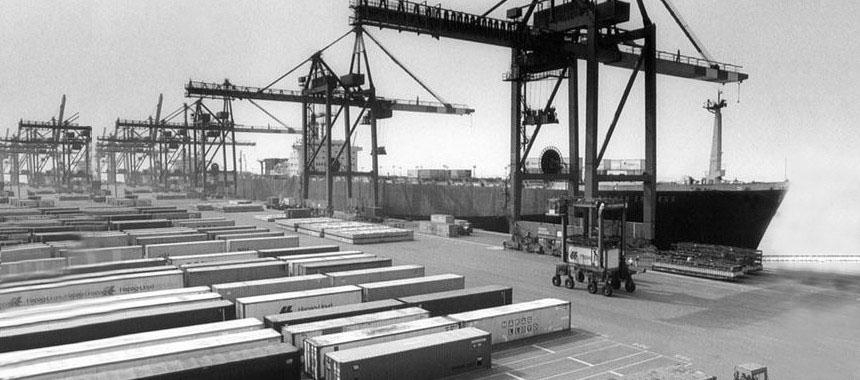 Container terminals in Bremerhaven in 1966
Container terminals in Bremerhaven in 1966
The current generation of containerships has pushed the limits of ship design and harbor capabilities. Similar to the super-tankers of the 1970s, containerships are now exceeding original expectations. In the late 1980s, American President Lines began construction of their C-10 and C-11 classes. The beam of these vessels exceeded the locks of the Panama Canal and introduced the world to post-Panamax container ships. Capable of carrying over 4,000 TEUs, these ships are now being eclipsed by even newer mega ships. Last year, Maersk Lines fielded the new G-class containerships, as demonstrated by the MV Gudrun Maersk, capable of handling 7,000 TEUs. Plans are in the works for ships capable of carrying up to 10,000 TEUs.
Containerization and intermodalism have radically altered the movement of cargo. Today’s merchant fleet worldwide consists of 3,375 containerships with a capacity of 7.2 million TEUs. They are divided into four distinct categories: «feeder» ships, those that carry less than a thousand TEUs and are designed to shuttle containers to and from small ports to larger ports; «handy-size» vessels of one to three thousand TEUs; «Panamax» ships of up to four thousand TEUs; and finally, «post-Panamax.» Their impact on the world’s trade is significant. In 1983 the total US foreign ocean-borne commerce was 694.4 million metric tons; ten years later, this had increased to 884.4. Ten years after that, it had magnified to 1,167.9 million metric tons, nearly doubling in just twenty years. Growth of this magnitude is only possible through the use of containers. Before containerization, a typical freighter could handle only 10,000 tons and took nearly two weeks to load/unload. In 2004 the port of Los Angeles/Long Beach alone accounted for 8.6 million containers, or thirty-six percent of the more than twenty-three million containers that moved in and out of the United States.
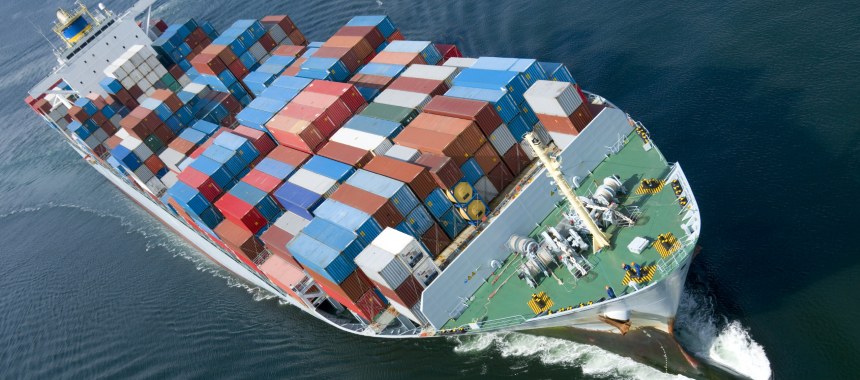 The container ship leaves from port
The container ship leaves from port
That translates to over 23,000 containers per day, with each TEU capable of carrying up to twenty tons of cargo-equal to loading/offloading approximately forty-five freighters daily.
Malcolm McLean passed away on 25 May 2001 at the age of 87 with little fanfare. Te Harvard Business School has acknowledged him as one of the greatest business leaders of the twentieth century. Tough his name may not be as well known in the maritime field as such innovators as Robert Fulton, Samuel Cunard, Ismbard Kingdom Brunel, Donald McKay, or Henry J. Kaiser, it is clear that his contribution to the industry was extraordinary.
Born in the small rural town of Maxton, North Carolina, he was a product of the Depression. Yet this truck driver reinvented ocean shipping, and his vision of containerizing cargo has transformed the world’s oceans into a true global highway.
- Comments
 en
en ru
ru uk
uk

